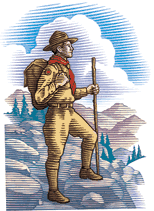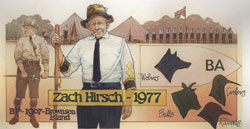![]() May-June 2001
May-June 2001

Brownsea as Brigadoon
By Zach Hirsch
Illustration by Joel Snyder
Unlike the mythical Scottish village, said to awaken for one day each century, the 1907 camp at which Baden-Powell tested his Scouting program comes to life every four years at the national Scout jamboree.

On July 31, 1907, Robert S. S. Baden-Powell, a retired British Army general, gathered about 20 English boys on Brownsea Island, off the south coast of England, for an experiment. For more than a week, they successfully tested a program for training boys that Baden-Powell called his Boy Scout "scheme." (See "The First Scout Camp," The Way It Was, Scouting, September 1999.)
As a 70th anniversary tribute to this historic event, I planned to stage a Brownsea reenactment at the 1977 National Scout Jamboree. Such reenactments had been part of world jamborees, but never a part of a BSA national jamboree. The volunteer leaders and Boy Scouts who assembled at Moraine State Park in Pennsylvania were determined to give attendees and visitors an action sample of Scouting's heritage and a look at where some of today's skills originated.
Researching the details
I received encouragement and suggestions from William (Green Bar Bill) Hillcourt, who had known Baden-Powell in the 1930s. In 1976, I visited the British Scout Association headquarters in London, where I was provided with copies of B-P's letters and reports and photos taken in 1907. I also visited his retirement home and grave site in Kenya.
A detailed reenactment program was developed using only those skills performed in 1907. We had four of the bell-shaped Army tents made, based on drawings. Eventually, the Brownsea marquee tent was added. Martin (Marty) Thames, a Scoutmaster and schoolteacher from Wayzata, Minn., portrayed the 50-year-old B-P. Thames played the role at the next two national jamborees. A nationwide call went out for youth staff, preferably those with theater experience, to play the original boys. The reenactment proved a great success.
Using 1907 photos, my wife, Kay, a theatrical costumer, created drawings, enabling the staff to duplicate what had been worn: knickers or long pants, shirts and ties, and either caps or boaters (straw hats). No uniforms yet. One problem was shoes. In 1977, most boys wore athletic shoes. Authenticity required brown or black lace-up shoes.
The original four patrols were recreated, complete with Scout staves and shoulder-knots (shoulder ribbons 18 inches long, folded and pinned). These indicated their patrol: Curlews, yellow; Ravens, red; Wolves, blue; Bulls, green. B-P wore a white one. Copies of the original patrol flags were provided, with the bird or animal head in silhouette and the letters BA—the first and last letters of Brownsea—as well as duplicates of the white cloth fleur-de-lis for the leaders' hats.
Every staff member became proficient in Brownsea skills: hut-building; the use of staves and hay; mat (mattress)-making; and the use of binder twine. Staff members also schooled themselves in the history of Great Britain's flag and the stories of English world explorers. They learned Kim's Game, the Old Spotty Face observation game, Flinging the Squailer (water rescue), signaling, the tracking pit, and tracking games.
A bit of England in Virginia
In 1981, Fort A.P. Hill in Virginia was designated as the official location for national jamborees. A permanent site for the Brownsea encampment was included, a bit of England in the Old Dominion.
After my 1984 retirement as director of BSA's National Activities Service, I continued to be associated with Brownsea, returning in 1989 and 1993 to portray Baden-Powell.
We designed activities to include both demonstrations and audience participation, and in 1989 we were able to get a leader and four Scouts from England to join the staff. William MacDougal, from Massachusetts, served as a second B-P that year, and Dave McGregor, from Michigan, spelled me occasionally in 1993. We recruited enough youth to have four patrols on the site and two more patrols touring the jamboree grounds, demonstrating a variety of additional skills.
Former World War II Royal Air Force pilot Jack May taped a cassette to help participants prepare for their roles. One side included instructions on how to imitate an English accent; the other had 12 popular songs from 1907.
Campers were encouraged to adopt the name and background of their 1907 counterparts. The staff became so believable that visitors were convinced we were all from England. Other than Pedro, the Boys' Life burro, I was probably the most photographed jamboree personality.
The most popular activity from 1989 on was the stave drill. B-P adapted it from the army rifle drill. We added the Robin Hood drill, based on combat techniques from that story.
We did encounter a few problems: long-stalk hay or straw was not available, making both hut- and mat-making difficult; some games were eliminated for safety reasons; and fire-making and cooking were not possible because of fire danger.
Each morning the British flag was raised, using the proper "flag break," followed by the singing of "God Save the King." Flag-lowering also followed the British procedure.
A reputation for quality
Over the years, the reputation of the staff grew. They appeared in both arena and staff shows, performed at a luncheon of international Scouters, and conducted headquarters flag ceremonies. Hillcourt celebrated a birthday on the site. Then-Chief Scout Executive Jere Ratcliffe was featured in the final segment of the 1993 jamboree video, speaking from the Brownsea camp.
In 1978 and again in 1982, Arthur Primmer, then the last remaining original Brownsea Scout, sent me an advance card, duplicated for the staff, showing the Bull Patrol in 1907, along with a personal message.
I continue to stay in close touch with the reenactment, serving as honorary chairman and providing material. And I portray B-P at Brownsea at numerous council events.
How well did it work? It continues to be a major feature of jamborees. Scouts, leaders, and visitors return to participate. Brownsea Island is, again, alive and well. The reenactment gives every participant at the jamboree a rare opportunity to see, in live action, the founding of the worldwide Scouting movement.
Zach Hirsch has been registered in Scouting for 68 years and was on the staff of eight national and three world jamborees. From 1974 to 1984 he worked at the BSA national office as director, National Activities Service; producer/director of national shows and program features; and as Scouting's liaison to the White House. He is currently rural public relations chairman of the Grand Canyon Council.
May-June 2001 Table of Contents
Copyright © 2001 by the Boy Scouts of America. All rights thereunder reserved; anything appearing in Scouting magazine or on its Web site may not be reprinted either wholly or in part without written permission. Because of freedom given authors, opinions may not reflect official concurrence.
| The Boy Scouts of America | http://www.scouting.org |